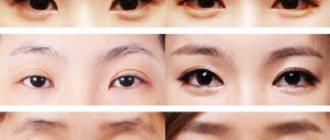Troxler effect
Image: @primaryeyecare1/Twitter If you stare at this image and focus on it for about 30 seconds, it will simply disappear.
You can click on it to open the full picture. The main thing is not to look away. Exposure
Exposure
This optical illusion is called the Troxler effect - it was described by Identifying Troxler back in 1804. The illusion occurs because our brain removes stationary objects from the retinal image - thus we do not notice the capillaries in our eye, scratches in the cornea, as well as defects in the lens and vitreous body. It also helps us not pay attention to our nose.
Typically, human eyes fixate on objects for 0.2–0.6 seconds, after which they make a reflexive movement Javal, É (1878). "Essai sur la physiologie de la lecture." Annales d'Oculistique (in French) round trip. This is necessary so as not to lose sight of the object. But when you resist the urge to shift your gaze and stare at the blurry image, your brain begins to cut it out, deeming it unimportant.
By the way, the Troxler effect affects other senses as well. It is thanks to him that you, for example, do not notice the smell of your cologne: sensory neurons get used to these stimuli and reject them as something insignificant.
The Jesus Illusion
Instructions:
This is one of the most popular afterimage illusions.
Look at the dots in the center of the image for about 60 seconds.
Then quickly close your eyes and look at a bright light source, such as a lamp. You can also look at the white wall.
You should see a white circle with the image of Jesus Christ.
Magic dress
Photo: @swiked/Tumblr
On February 26, 2015, a photo of a lace dress from Roman Originals was published on the social network Tumblr, which instantly went viral. Click on the picture to expand it.
Social media users argued fiercely about what color it was: blue and black or white and gold. And the BuzzFeed resource conducted a survey, as a result of which two-thirds of its participants decided What Colors Are This Dress? that the dress is still white and gold.
Exposure
Exposure
But the dress is actually blue with black stripes - here it is on the manufacturer's website.
Neuroscientists Bevil Conway and Jay Neitz explain Viewpoint: Blue and black or white and gold? the phenomenon of the dress is so. Humans have the ability to chromatically adapt - thanks to it, we perceive colors approximately the same at different times of the day. That is, a red strawberry, for example, appears red to us in the morning, during the day, and in the evening, because our brain is accustomed to seeing it that way, even if the lighting changes color.
This ability plays a cruel joke on us in the case of the dress, since the colors in the photo are not conveyed correctly. Bevil Conway suggests, The Science of Why No One Agrees on the Color of This Dress, The Science Behind the Dress, that daytime people tend to see the dress as white, while nightlife people tend to see the dress as blue. Everyone subconsciously chooses the colors that they see most often.
Volume illusion
Photo: Casa Ceramica
There is a visible dent in the floor. Was it done by accident or intentionally? And if intentionally, then how and why?
Exposure
Exposure
If you look at This wavy floor is actually a mind‑boggling optical illusion that stops people from running in the hallway at the “dent” from any point of view, without being in front of the door, it will disappear.
Correct, here is the view back the other way @casaceramica pic.twitter.com/c6LaVIw1sW
— Duncan Cook (@DuncanCook10) September 22, 2017
The thing is that the manufacturers of finishing materials from the Casa Ceramica company prepared the tiles in a special way so that the shape of its individual fragments creates a “crater” effect. This floor is in one of the Casa Ceramica showrooms in Manchester and was designed to make people move more slowly and carefully through the corridors.
Cognitive Straightening: Full Exposure Illusion Session
In the illustration above you see a diagram of cognitive distortions - systematic deviations in the perception of reality. You can see the full version of the picture in Russian
, and at this link you will find the original data in JSON format.
175 fascinating cognitive bugs did not appear out of nowhere - each has a root cause, although in some cases scientists have not fully determined the source of the perception error. Typically, distortion is preceded by an overabundance of information, difficulty understanding, the need to respond quickly, or limitations of our memory. But the most common reason is the peculiarities of human thinking. One of the most interesting types of errors is optical illusions. Today we’ll talk about exactly this, since visual illusions best demonstrate the ways the brain creates a sense of reality within itself. By studying these mechanisms, we better understand how to make a virtual world indistinguishable from the physical one.
Wild, wild world
From an evolutionary point of view, everything interesting about the brain happened yesterday.
While you are sitting in the office, the neurons are awake and ready to send your body on a journey - away from the saber-toothed tiger, treacherously jumping from the top of the boulder. Neuroscientist Bo Lotto argues that we don’t actually see reality, and our senses, designed to help us understand the world around us, interfere with its objective perception. To illustrate this idea, he offered the following drawing.
The square on the top edge seems dark brown to us, while on the side it appears brighter – brownish-orange. However, this is just an illusion created by our brain. In reality the cube looks different.
How is this possible? In very low light, individual colors are indistinguishable. From the point of view of survival, such a state of reality is destructive, since a predator hidden in the darkness can attack a person. And then a “perception error” comes to the rescue: an image is formed on the retina that differs from the object that created it.
For example, in an evening forest we perceive the movement of bushes as a living object. And only after looking closer do we realize that these are actually branches moving from a light breeze. The brain was wrong, but evolutionarily the “fight or flight” mechanics are more beneficial than the “stand and analyze” response. It is better to mistakenly see different colors, movements and threats than to be eaten one day.
The Müller-Lyer illusion: a classic deception
The German psychiatrist Franz Karl Müller-Lyer in 1889 showed a geometric-optical illusion associated with a distortion of the perception of lines and figures. The Müller-Lyer illusion is that a segment framed by outward-facing tips appears shorter than a segment framed by tails, but in fact both segments are the same length.
The psychiatrist also drew attention to the fact that the contemplator of the illusion, even after measuring the lines and listening to an explanation of the neurological background of the image, continues to consider one line shorter than the other. It is also interesting that this illusion does not look the same for everyone and there are people less susceptible to it.
Attempts have been made to explain how the Müller-Lyer illusion works:
- “wrong size”: the image of the arrowheads falls on the part of the visual system in the retina responsible for processing depth signals in images. As a result, a line with tips pointing inward is interpreted as longer because it is perceived by the retina as being further away;
- “conflicting signals”: arrowheads are perceived as contributing to the length of the line, accordingly a longer overall line shape with arrowheads pointing inward causes the effect of increasing the length of the line;
- "confusion": the distance between the tips affects the perceived length. Thus, for a line with outward-pointing arrowheads, the distance between the arrowheads appears smaller than the distance between the inward-pointing arrowheads on the other line.
We still don’t know the correct answer, so you can offer your version or support one of the existing ones. In any case, Müller-Lyer's work made a major contribution to the development of cognitive science. It became clear that the mind is a far from perfect mechanism, which can make mistakes even when working with accurate, at first glance, complete information, cleared of the influence of emotions.
The brain processes information in a number of interconnected modules, and one module may not be aware of the existence of another. Some modules are a kind of semi-independent departments of consciousness, dealing with certain types of input data and producing certain types of output data. Their inner workings are not accessible to human awareness - everything that we can access is the result of the work of hidden internal systems.
The Müller-Lyer illusion shows that some module continues to show us different line lengths, despite the knowledge that this is incorrect. Another well-known illusion of this kind is called vertical-horizontal. In the picture above, the vertical line appears to be longer than the horizontal line, but in reality they are equal.
With the dynamic Müller-Lyer illusion, the animated arrows appear to change the length of the lines, but in fact they remain the same.
Pinna-Brelstaff illusion: brain bugs
In 1990, thanks to the work of Bainio Pinna (University of Sassari, Italy), the first visual illusion showing the effect of rotating motion appeared. The illusion was presented in its modern form in 2000 in a joint article by Bainio Pinna and English psychologist Gavin Brelstaff.
The Pinna-Brelstaff illusion consists of several concentric rings consisting of small diamond-shaped elements angled in different directions in the inner and outer rings. Depending on whether you are moving closer or further from the image, the circles spin in different directions. But this illusion will disappear if the diamonds are not placed at an angle.
As you move closer to the monitor, the circles on the screen should appear larger to your brain, but the neurons responsible for detecting motion “tell the lie” and create the illusion. It is believed that the illusion is caused by “bugs” in the neurons of the visual cortex of the brain. When looking at a static picture, neurons in this area take 15 milliseconds longer to activate than when normally perceiving real complex movement.
Scientists believe that understanding the mechanics of motion perception will help avoid situations in which it is dangerous to stimulate the movement-sensitive area in the cerebral cortex. Thus, incorrect visual content on the dashboards of cars, airplanes and other modes of transport can cause irreparable harm. Designers, directors, and multimedia content creators should also think about preventing motion sickness and other discomfort for viewers.
The Work of Richard Russell: The Illusion of Sexual Difference
In the illustration you can see a man and a woman. But that's not true. In 2009, Richard Russell, a professor of psychology at Gettysburg College in the US, showed that both faces are actually versions of the same androgynous face.
The original picture was created on a computer by mixing average male and female faces. The only difference is the contrast: in the photo on the left the contrast and illumination of the facial features are increased, on the right they are decreased.
A face with greater contrast is perceived as female. It is not known exactly why this was necessary from an evolutionary point of view, but a woman’s face has a greater contrast of light in the area of the eyes, lips and surrounding skin than a man’s.
Russell's original study is called "A sex difference in facial pigmentation and its exaggeration by cosmetics." Contrast is an important signal for the perception of gender - the more contrasting a woman’s appearance is by nature, the more beautiful a woman appears, so cosmetics that create contrast make a woman more attractive.
Coffer illusion: long lags
In the picture above, most people initially see only the squares and only after a few seconds begin to distinguish the 16 oval circles.
Anthony Norzia of the Smith-Kettlewell Eye Research Institute (San Francisco, USA) demonstrated the "coffer" illusion in 2006, an architectural term meaning a series of recessed door panels in square, rectangular or other shapes.
The Coffer illusion belongs to a large class of optical distortions in which a two-dimensional figure or three-dimensional object can be seen in several distinct ways. Neuroscience provides evidence that illusions arise for some ambiguous figures because our brains are wired to constantly identify objects.
We do not see objects as a whole, but in the form of individual faces, contours and figures, which after a short processing are grouped into something understandable to our consciousness. However, if the image is inherently ambiguous, the same set of equal elements can be interpreted differently - for example, forming a circle or a rectangle.
The “Mask of Love” illusion, taken from the book “Amazing Optical Illusions” by Gianni Sarcone, works similarly, with the only difference that the image of one face or two kissing faces does not have one dominant role - what you see depends only on individual characteristics your brain.
Interestingly, in this way the brain not only processes information about objects, but also recognizes people’s faces. The brain reads a collection of individual elements - eyes, nose, mouth and ears. In addition to the individual characteristics of facial features, their relationship with each other and location are taken into account. That is, the face is perceived as an integral system. The result is the Thatcher illusion, where local changes in an upside-down portrait photo are difficult to detect.
At first, the upside-down photo of Margaret Thatcher seems normal, but if it is turned 180 degrees again, the incorrect position of the eyes and mouth is immediately obvious. In an inverted photograph, it is more difficult for the brain to evaluate the image as a whole - information is “collected” separately for each element.
As soon as we are shown the correct face, suddenly the perception of a single system is reconnected. An area of the cerebral cortex recognizes a face and determines the direction of gaze, the amygdala and insula analyze facial expressions, and an area in the prefrontal zone of the frontal lobe and the brain's pleasure system evaluates its beauty.
Optical illusions in art
Optical illusions have been known to people for hundreds of years and, of course, have served as a source of inspiration for artists. In fine art, there is an artistic technique associated with optical displacement, which shows an object of an easily recognizable shape only from a certain point of view. It was called anamorphosis - from the Greek ἀνᾰ- (prefix with the meaning of repetition) and μορφή (“image, form”).
In the famous painting “The Ambassadors” by Hans Holbein the Younger, painted in 1533, there is hidden an opaque symbol of the eternal presence of death in everyday life, which only those who “see clearly” reality in a deep understanding of existence are able to see. The easiest way to demonstrate Holbein's mastery of anamorphosis is through video.
Intentional distortion of the image creates a special effect. This technique was used by Maurits Escher. Thus, in the work “Belvedere” he created a two-dimensional image of a building for viewing the surrounding area, free from the shackles of the three-dimensional world.
To the viewer, the columns on the second floor are the same size both front and rear, but the columns at the rear are set higher. The viewer will also notice that the top floor is at a different angle than the rest of the building. The posts on the middle floor are at right angles, but the front posts support the back side of the top floor while the back posts support the front side.
Influence of neuroprocesses
At the foot of the Escher belvedere, a man looks at the Necker Cube, another optical illusion also called the impossible cube because of the edges that intersect in an impossible way. There is a hypothesis that neurophysiological channels in the human visual system selectively process depth information. These channels operate on the principle of mutual complementation - every 2-3 seconds one is activated and the second is suppressed, or vice versa.
This hypothesis may also explain the phenomenon of more frequent variant changes during long-term follow-up. It is assumed that in this case the recovery processes do not have time to complete and the replacement of one option by another occurs faster. Examples of multi-depth-stable images include the “tile wall” illusion, in which rows of tiles appear to be curved, although they are not curved at all, Schroeder’s staircase, etc.
There are actually a great many hypotheses explaining the existence of various types of illusions.
We need all of them to fully understand the processes of identifying ourselves and objects in reality. On the other hand, illusions are simply interesting to watch, when even ordinary perspective in paintings is a real illusion of perception. The popularity of cognitive and optical distortions has reached such heights that the neurological research society Neural Correlate Society, with the support of the Mind Science Foundation, began to regularly hold the “Best Visual Illusions of the Year” competition, where the number of interesting illusions literally dazzles the eye. We recommend it to everyone.
Cat walking on the stairs
Photo: 9Gag.com / Public Domain
This photo of a cat appeared on the Internet back in 2015, and since then people who have seen it have been wondering: is this cat going up or down the stairs?
Exposure
Exposure
After a thorough study of The cat is definitely going down the stairs - here's how you can tell, Business Insider came to the conclusion that the cat is still going down. This is indicated by the protruding upper thresholds of the steps. Additionally, the cat's posture—tail held for balance, gaze directed toward the steps—confirms that he is moving downward, not upward.
Illusions associated with the structural features of the eye
Description
The optical system of the eye is not free from spherical and chromatic aberrations.
The essence of spherical aberration
consists in the fact that the focus for rays entering the eye parallel to its axis and at a small distance from it is further from the pupil than the focus for rays more distant from the axis. The edges of the pupillary space refract light more strongly than its middle. Partly for this reason, as stated earlier, we see small light sources in the form of radiant stars. It is easy to verify the presence of spherical aberration of the eye by performing this experiment. If printed text is placed in front of the eye closer to the distance of best vision, when it is no longer possible to clearly see the letters, and then take a piece of paper with a small hole and place it in front of the eye, then the letters will again become clearly visible. If we hold a black thread in front of a bright flame, it appears to us to be torn—circles of light scattering on the retina cover the thread on both sides and make it invisible. In an effort to better see an object, we “squint”, bringing our eyelids closer together, and thereby reducing the hole through which rays of light pass into the eye. As a result, the edges of the pupil and lens are “switched off” from operation, spherical aberration is reduced, and we see the object more clearly and sharply. In bright light, when the pupil constricts, spherical aberration decreases and we see better.
The eye is not an achromatic system
: the focus of violet rays is located 0.43 mm closer to the lens than the focus of red rays if the eye is accommodated to infinity. Therefore, objects, especially white ones, illuminated by white light, produce an image on the retina surrounded by a colored border. We usually don't notice it because it is very weak. However, it can be easily detected with the help of simple experiments, for example, by looking at Fig. 5.
Rice. 5.
If we bring this drawing very close to the eye, we will see colored borders near the black circles. This indicates that the eye is not free from chromatic aberration.
We will observe the same effect if we look through a small hole in a piece of paper at the edge of the roof against the background of a bright sky. Raising the piece of paper so that the rays fall on the periphery of the pupil, we will notice that the sky near the roof will appear reddish. The above can be easily explained if we remember that an inverse image is obtained on the retina and that when rays fall on the edge of the lens, blue rays are refracted more strongly than red ones. Chromatic aberration of the eye and lenses of optical instruments creates difficulties when viewing scales or interference fringes, as well as when observing celestial bodies using astronomical instruments.
There are known cases of myopia occurring in people only at dusk.
when the outlines of visible objects become less sharp.
If the clear visibility of objects is limited to a distance of 2 m, then the resulting myopia corresponds to 0.5 diopters. During the day, the eye has maximum sensitivity in the yellow-green part of the spectrum, and at dusk the maximum sensitivity shifts to the blue-green part. The eye, like a lens, refracts blue-green rays more strongly than yellow ones. Consequently, night myopia occurs in people due to chromatic aberration of the eye. In addition, in low light, the pupil of the eye dilates and the edges of the lens begin to play a large role in forming the image on the retina. Consequently, night myopia is to some extent due to spherical aberration of the eye
.
Astigmatism of the eye
. Astigmatism of the eye is a defect of the eye, usually caused by the non-spherical (toric) shape of the cornea and sometimes the non-spherical shape of the surfaces of the lens.
Astigmatism in the human eye was first discovered in 1801 by the English physicist T. Young. In the presence of this defect (by the way, not all people manifest it in a sharp form), there is no point focusing of rays falling parallel to the eye due to different refraction of light by the cornea in different sections.
With strong astigmatism, a person sees clearly, for example, only vertical lines, and sees horizontal lines blurred, or vice versa (Fig. 6).
Rice. 6.
The astigmatic eye sees figure A as it is shown on the right.
Severe astigmatism can be corrected with glasses
with cylindrical glasses that refract light rays only in the direction perpendicular to the axis of the cylinder.
Eyes completely free from this defect are rare in humans, as can be easily seen by looking at the figures shown here. 7, 8 and 9.
Rice. 7.
Concentric, close to each other circles appear interrupted, not equally distant from each other.
Rice. 8.
The identical (monochromatic) shading of the quadrants of this circle does not seem equally bright.
Rice. 9.
Certain letters appear darker depending on the position of the pattern relative to the eye.
To test the eyes for astigmatism, ophthalmologists often use a special table
(Fig. 10),
Rice. 10.
Figure to determine the degree and measure of astigmatism of the eye.
where twelve circles have shading of equal thickness at equal intervals. An eye with astigmatism will see the lines of one or more circles blacker. The direction of these blacker lines allows us to draw a conclusion about the nature of the astigmatism of the eye.
If astigmatism is due to the non-spherical shape of the lens surface, then when moving from clear vision of horizontal objects to viewing vertical objects, a person must change the accommodation of the eyes.
Most often, the distance of clear vision of vertical objects is less than horizontal ones. This is partly due to the visual defect of "overestimation of vertical lines"
, which will be discussed below.
When viewing concentric circles (Fig. 7) from a short distance, an impression is sometimes created similar to watching a rotating propeller. This phenomenon is explained by fluctuations in the curvature of the lens surfaces
in our attempt to obtain a sharp image of the various sectors of these circles on the retina.
Blind spot
. The presence of a blind spot on the retina of the eye was first discovered in 1668 by the famous French physicist E. Mariotte. Marriott describes his experience in verifying the presence of a blind spot as follows: “I attached a small circle of white paper on a dark background, approximately at eye level, and at the same time asked to hold another circle to the side of the first, to the right at a distance of about two feet. , but slightly lower so that its image falls on the optic nerve of my right eye, while I close my left eye. I stood opposite the first circle and gradually moved away, keeping my right eye on it. When I was 9 feet away, the second circle, which was about 4 inches in size, completely disappeared from view. I could not attribute this to his lateral position, because I could distinguish other objects that were even more to the side than he was; I would have thought that it had been removed if I had not found it again at the slightest movement of the eyes.” It is known that Marriott amused the English king Charles II and his courtiers by teaching them to see each other without heads.
The retina of the eye where the optic nerve enters the eye
, does not have photosensitive endings of nerve fibers (rods and cones). Consequently, images of objects falling on this place of the retina are not transmitted to the brain.
You can verify the presence of a blind spot
, looking at any of Fig. 11, 12 and 13.
Rice. eleven.
Rice. 12.
Rice. 13.
Close your left eye and look with your right eye at the figure depicted on the left, holding the drawing at a distance of 15-20 cm from the eye. At a certain position of the drawing relative to the eye, the image of the right figure will cease to be visible. Rice. 11 and 13 allow you to detect the blind spot of both the right and left eyes.
In these figures, the blind spot for the right eye is found to the right of the central ray, and for the left eye it is to the left. Under these conditions, in the first case the right part of the picture disappears, and in the second the left. Therefore, for the right eye you need to set the pattern so that the left part of the pattern is directly opposite the eye (for example, the central circle in Fig. 11 and 12 or the cross in Fig. 13), and for the left eye - the right part of the pattern. Then, if necessary, remove or zoom in on the drawing, or move it little by little to the side until a clear effect is achieved.
Academician S.I. Vavilov wrote about the structure of the eye: “How simple the optical part of the eye is, so complex is its perceptive mechanism. We not only do not know the physiological meaning of individual elements of the retina, but we are not able to say how appropriate the spatial distribution of light-sensitive cells is, what the blind spot is for, etc.
What we have before us is not an artificial physical device, but a living organ, in which advantages are mixed with disadvantages, but everything is inextricably linked into a living whole.”
A blind spot, it would seem, should prevent us from seeing the entire object, but under normal conditions we do not notice this. Firstly
, because the images of objects falling on the blind spot in one eye are not projected onto the blind spot in the other;
secondly
, because the falling parts of objects are involuntarily filled with images of neighboring parts that are in the field of view.
If, for example, when examining black horizontal lines, some areas of the image of these lines on the retina of one eye fall on a blind spot, then we will not see a break in these lines, since our other eye will compensate for the shortcomings of the first
.
Sections of “straight lines” passing through the blind spot of any eye will be continued by our consciousness along the shortest path, even if in reality the lines have a break or bend in this place. So, for example, if the blind spot is opposite the “middle of the cross,” we will “see” the cross even if in reality its four branches do not connect in the middle. Here's another interesting experience
. If we hold a sheet of white paper with a red spot in front of us so that this red spot is not visible, for example with the right eye, we will still see the spot with the left eye, i.e. we will see a sheet of paper with a red spot, which is true. If you take completely white paper and hold red glass in front of your left eye, then the whole paper will appear reddish-white, and the place corresponding to the blind spot of the right eye is no different from the rest of the background. Even when observing with one eye, our mind compensates for the deficiency of the retina and the disappearance of some details of objects from the field of vision does not reach our consciousness. The blind spot is quite large (at a distance of two meters from the observer, even a person’s face can disappear from the field of view), however, under normal vision conditions, the mobility of our eyes eliminates this “disadvantage” of the retina.
Irradiation
. The phenomenon of irradiation is that light objects against a dark background seem enlarged compared to their actual size and seem to capture part of the dark background. This phenomenon has been known since very ancient times. Even Vitruvius (1st century BC), an architect and engineer of ancient Rome, pointed out in his writings that when dark and light are combined, “light devours darkness.” On our retina, light partially captures the space occupied by shadow.
Initial explanation of the irradiation phenomenon
was given by R. Descartes, who argued that an increase in the size of light objects occurs due to the spread of physiological excitation to places adjacent to the directly irritated area of the retina.
However, this explanation is currently being replaced by a new, more strict one, formulated by Helmholtz, according to which the following circumstances are the root cause of irradiation.
Each luminous point is depicted on the retina of the eye in the form of a small scattering circle due to the imperfection of the lens, inaccurate accommodation, etc.
When we look at a light surface against a dark background, due to aberration scattering, the boundaries of this surface seem to move apart
, and the surface seems to us larger than its true geometric dimensions; it seems to extend across the edges of the dark background surrounding it. The effect of irradiation is more pronounced the worse the eye is accommodated.
Due to the presence of circles of light scattering on the retina, under certain conditions (for example, very thin black threads), dark objects on a light background can also be subject to illusory exaggeration - this is the so-called negative irradiation
.
There are a lot of examples when we can observe the phenomenon of irradiation; it is not possible to give them in full here. The presence of irradiation is clearly confirmed in Fig. 14-19.
Rice. 14.
The white square on the black background on the right appears larger than the black square on the light background on the left.
Rice. 15.
White figures on a black background appear larger than black figures on white.
Rice. 16.
The part of the lunar disk illuminated by light reflected from the Earth appears smaller in diameter than the bright crescent of the Moon illuminated by the Sun.
Rice. 17.
The square is crossed by two wide black stripes that appear pinched where they touch the sides of the square (as shown on the left).
Rice. 18.
The crosshairs of the black stripes appear not black, but gray. This effect can only partly be explained by irradiation.
Rice. 19.
Wires crossing at sharp angles appear to be broken, as shown at the bottom of the picture. If the wind swings the wires, then the white gap oscillates in time with these swings.
The great Italian artist, scientist and engineer Leonardo da Vinci in his notes says the following about the phenomenon of irradiation:
“When the Sun is visible behind leafless trees, all their branches opposite the solar body are so reduced that they become invisible, the same will happen with the shaft placed between the eye and the solar body. I saw a woman dressed in black with a white bandage on her head, the latter appearing to be twice the width of the woman's shoulders, who were dressed in black. If you look at the battlements of the fortresses from a great distance, separated from each other by gaps equal to the width of these battlements, then the gaps seem much larger than the battlements..."
The great German poet Goethe points out a number of cases of observations of the phenomenon of irradiation in nature in his treatise “The Doctrine of Colors”. He writes about this phenomenon like this:
“A dark object appears smaller than a light one of the same size. If we simultaneously consider a white circle on a black background and a black circle of the same diameter on a white background, then the latter seems to us to be about 1/5 smaller than the first. If the black circle is made correspondingly larger, they will appear equal. The young crescent of the moon seems to belong to a circle of a larger diameter than the rest of the dark part of the moon, which is sometimes distinguishable."
The phenomenon of irradiation during astronomical observations
interferes with observing thin black lines on objects of observation; in such cases it is necessary to aperture the telescope lens. Physicists, due to the phenomenon of irradiation, do not see the thin peripheral rings of the diffraction pattern. Danish experts, having studied the statistics of car accidents in European countries, came to the conclusion that 61% of all accidents occurred with cars painted black. Only 6% are light-colored cars. Experiments have shown that black painting seems to remove the car.
People appear thinner in a dark dress than in a light one. Light sources visible from behind the edge produce an apparent cutout in it. The ruler, from behind which the candle flame appears, is represented with a notch in this place. The rising and setting sun makes a hole in the horizon.
A few more examples
. The black thread, if held in front of a bright flame, seems to be broken at this point; the hot filament of an incandescent lamp seems thicker than it actually is; light wire against a dark background appears thicker than against a light one. The sashes in the window frames appear smaller than they really are. A statue cast in bronze appears smaller than one made from plaster or white marble.
The architects of Ancient Greece made the corner columns of their buildings thicker than others, taking into account that these columns from many points of view would be visible against the background of a bright sky and, due to the phenomenon of irradiation, would appear thinner.
We are subjected to a kind of illusion in relation to the apparent size of the Sun. Artists, as a rule, paint the Sun as too large compared to other depicted objects. On the other hand, in photographic landscape photographs that also depict the Sun, it appears to us unnaturally small
, although the lens gives the correct image of it.
Note that the phenomenon of negative irradiation can be observed in such cases
when a black thread or slightly shiny metal wire appears thicker on a white background than on a black or gray background. If, for example, a lacemaker wants to show her art, then it is better for her to make lace from black threads and spread it on a white lining. If we observe wires against a background of parallel dark lines, such as a tile roof or brickwork, the wires appear thickened and broken where they intersect each of the dark lines. These effects are also observed when the wires are superimposed in the field of view on a clear outline of the building.
It is likely that the phenomenon of irradiation is associated not only with the aberration properties of the lens
, but also with the scattering and refraction of light in the media of the eye (the layer of fluid between the eyelid and the cornea, the media filling the anterior chamber and the entire inside of the eye). Therefore, the irradiation properties of the eye are obviously related to its resolving power and radiant perception of “point” light sources. For example, to perceive the entire figure (Fig. 20)
Rice. 20.
Black lines are sharply distinguishable only in some radial directions; in others they merge into a gray background. To perceive the entire figure, the eye must make circular movements.
the eye should make circular movements.
The ability of the eye to overestimate sharp angles is associated with aberration properties, and therefore partly with the phenomenon of irradiation, which will be discussed below.
—-
Article from the book: Visual illusions | 3rd edition | Artamonov I.D.
Crazy Hugs
Photo: @Blood_Reaper / Reddit
This photo shook up Reddit in 2021 when it was shared by user Blood_Reaper. Click on it to open it fully and take a look at the legs of the people hugging. Do both pairs of limbs belong to a tall, dark guy? Or did the girl put her legs under it?
Exposure
Exposure
If you take a closer look at the photo, you can easily understand that the man’s shorts are black on the sides and white in the middle. They blend in with the white trousers the woman is wearing.
Green Cylinder Gambit
Image: Wikimedia Commons
This optical illusion was created by ophthalmology professor Edward H. Adelson of the Massachusetts Institute of Technology. Look closely at tiles A and B. Do you think they are different in color?
Exposure
Exposure
And completely in vain. The tiles are the same color, as you can see by looking at this picture.
Image: Wikimedia Commons
Or open it in Photoshop or any other editor and compare color samples taken with the Eyedropper tool.
The tile next to the cylinder appears darker to us because our brain compares the object's color to the colors around it. Square A is surrounded by lighter squares, making it darker, and square B appears lighter against the background of dark squares.
What are optical illusions?
There are many types of illusions. Scientists classified them according to different criteria: perception of the size of objects, colors, size of figures depending on the background, apparent objects, movement, depth. This also includes conditions created by nature. Let's briefly look at the most famous and interesting of all.
There are optical illusions created by nature. A well-known example is a mirage in the desert. A person, in turn, can also create imaginary phenomena and objects using visual effects, for example, floating in the air (levitation). People have learned to understand natural optical illusions, also creating illusory visual pictures. The illusion of color perception is one of the most famous types, which arises due to the special structure of the retina.
The effect of false perception of size is due to the fact that vision quite often incorrectly estimates geometric quantities. One study found that our eye can be off by up to 25% in its measurements, since its estimates are highly dependent on the nature of the background of these images. There have been cases when one phenomenon had several variants of scientific explanations. This suggests that there is still a lot of unexplored and mysterious things in this area, despite many years of research.
MagazinLinz.ru team
Pink/blue sneakers
Photo: @dolansmalik/Twitter
In 2021, a photograph circulated on Twitter People can't tell if these sneakers are pink or gray - but there's a simple way to find the truth of a sneaker that caused fierce controversy. Users couldn’t decide what color it was—pink-white or gray-turquoise. How do you think?
Exposure
Exposure
The sneaker is actually pink. One Twitter user "normalized" the colors in this low-light photo, giving the shoes their natural look. By the way, the hand also began to look normal, and not cyanotic.
Toy railroad
Image: @Marc Blank-Settle / Twitter
This photo was posted by BBC presenter Marc Blank-Settle on Twitter. It shows two parts of a toy railroad. They can be connected, and a train will travel along the road. Which part is larger in your opinion?
Exposure
Exposure
Take a look at this video and you will see that the parts are the same. This optical illusion is called the Jastrow illusion, named after the American psychologist.
My toddler's train track is freaking me out right now. What is going on here?! pic.twitter.com/9o8bVWF5KO
— Marc Blank‑Settle (@MarcSettle) April 6, 2016
Back in the 19th century, he discovered that two identical curved shapes would be visually different in size if they were aligned along the edge. Unfortunately, it is still unclear why our brains cause us to see shapes the way they do.
Why optical illusions trick our brains
People have been familiar with optical illusions for thousands of years. The Romans made 3D mosaics to decorate their homes, the Greeks used perspective to build beautiful pantheons, and at least one Paleolithic stone figurine depicts two different animals that can be seen depending on your point of view.
Mammoth and bison
A lot can get lost on the way from your eyes to your brain. In most cases this system works great. Your eyes move rapidly and almost imperceptibly from side to side, delivering scattered pictures of what is happening to your brain. The brain organizes them, determines the context, putting the puzzle pieces together into something that makes sense.
For example, you are standing on a street corner, cars are passing through a pedestrian crossing, and the traffic light is red. Pieces of information add up to a conclusion: now is not the best time to cross the street. Most of the time this works great, but sometimes, even though your eyes are sending visual signals, your brain makes a mistake in trying to decipher them.
In particular, this often happens when templates are involved. Our brain needs them to process information faster, using less energy. But these same patterns can lead him astray.
As you can see in the image of the chessboard illusion, the brain doesn't like to change patterns. When small specks change the pattern of a single chess square, the brain begins to interpret them as a large bulge in the center of the board.
Chess board
The brain also often makes mistakes about color. The same color can look different on different backgrounds. In the image below, both of the girl's eyes are the same color, but by changing the background, one appears blue.
Illusion with color
The next optical illusion is the Cafe Wall Illusion.
Cafe wall
Researchers at the University of Bristol discovered this illusion in 1970 thanks to a mosaic wall in a cafe, which is where it gets its name.
The gray lines between the rows of black and white squares appear to be at an angle, but in fact they are parallel to each other. Your brain, confused by the contrasting and closely spaced squares, sees the gray lines as part of a mosaic, above or below the squares. As a result, the illusion of a trapezoid is created.
Scientists suggest that the illusion is created due to the joint action of neural mechanisms at different levels: retinal neurons and visual cortex neurons.
The illusion with arrows has a similar mechanism of action: the white lines are actually parallel, although they do not seem so. But here the brain is confused by the contrast of colors.
Illusion with arrows
An optical illusion can also be created due to perspective, for example, like the chessboard illusion.
Illusion with perspective
Due to the fact that the brain is familiar with the laws of perspective, it seems to you that the distant blue line is longer than the green one in the foreground. In fact they are the same length.
The next type of optical illusion is pictures in which you can find two images.
Bouquet of violets and Napoleon's face
In this painting, hidden between the flowers are the faces of Napoleon, his second wife Marie-Louise of Austria and their son. Such images are used to develop attention. Found faces?
Here is another picture with a double image called “My Wife and Mother-in-Law.”
Wife and mother-in-law
It was invented by William Ely Hill in 1915 and published in the American satirical magazine Puck.
The brain can also add color to pictures, as in the case of the fox illusion.
Fox illusion
If you look at the left side of the fox picture for a while and then move your gaze to the right side, it will turn from white to reddish. Scientists still do not know what causes such illusions.
Here's another illusion with color. Look at the woman's face for 30 seconds and then look at a white wall.
Illusion with a woman's face
Unlike the fox illusion, in this case the brain inverts the colors - you see a projection of a face on a white background that acts as a movie screen.
Here's a visual demonstration of how our brain processes visual information. In this incomprehensible mosaic of faces, you can easily recognize Bill and Hillary Clinton.
Bill and Hillary Clinton
The brain creates an image from pieces of information received. Without this ability, we would not be able to drive a car or cross the road safely.
Now try to read the text in the picture below.
When you first learn to read, you read each letter, but then your brain remembers whole words, and as you read, you recognize them as a whole image, skimming over the first and last letters.
The last illusion is two colored cubes. Is the orange cube inside or outside?
Cube illusion
Depending on your point of view, the orange cube may be inside the blue cube or floating on the outside. This illusion works due to your perception of depth, and the interpretation of the picture depends on what your brain considers true.
As you can see, despite the fact that our brain copes well with everyday tasks, in order to deceive it, it is enough to break the established pattern, use contrasting colors or the desired perspective.
How often do you think the brain is deceived in this way in real life?
twelve points
Image: Akiyoshi Kitaoka Facebook Page
Click on this image to open it in full and look for the 12 black dots. Try to see them all at once.
Exposure
Exposure
This illusion was first published by Jacques Ninio and Kent A. Stevens in 2000 in the academic journal Perception. It gained considerable popularity when psychology professor Akioshi Kitaoka at Ritsumeikan University in Kyoto shared it on Facebook.
The illusion is a variation of the famous “Hermann grid” created by German physiologist Ludimar Hermann in 1870. As a result of the imperfections of our retina, we see gray spots at the intersections of white lines where there are none. On the contrary, on the grid from Ninio and Stevens, points located in the area of peripheral vision are not visible.
The reason is that we do not have very good peripheral vision. Therefore, the brain thinks out those fragments to which we do not pay direct attention. We see one black dot, while the rest are out of focus. The brain does not attach importance to them and simply does not draw them.
Optical illusion - pictures of illusions with explanationsDon't take optical illusions seriously, trying to understand and solve them, it's just how our vision works. This is how the human brain processes visible light from reflected images. Unusual shapes and combinations of these pictures make it possible to achieve a deceptive perception, as a result of which it seems that the object is moving, changing color, or an additional picture appears. All images are accompanied by explanations: how and how long you need to look at the picture to see something that is not really there.
For starters, one of the most talked about illusions on the internet is the 12 black dots. The trick is that you can't see them at the same time. A scientific explanation for this phenomenon was discovered by the German physiologist Ludimar Hermann in 1870. The human eye stops seeing the full picture due to lateral inhibition in the retina.
These figures move at the same speed, but our vision tells us otherwise. In the first gif, four figures move simultaneously while they are adjacent to each other. After separation, the illusion arises that they are moving along black and white stripes independently of each other. After the zebra disappears in the second picture, you can verify that the movement of the yellow and blue rectangles is synchronized.
Look carefully at the black dot in the center of the photo while the timer counts down 15 seconds, after which the black and white image will turn into color, that is, the grass is green, the sky is blue, and so on. But if you don’t stare at this point (to amuse yourself), the picture will remain black and white.
Without looking away, look at the cross and you will see a green spot running along the purple circles, and then they will completely disappear.
If you look at the green dot for a long time, the yellow dots will disappear.
Stare closely at the black dot and the gray stripe will suddenly turn blue.
If you cut a chocolate bar 5 by 5 and rearrange all the pieces in the order shown, an extra piece of chocolate will appear. Do this trick with a regular chocolate bar and it will never run out. (Joke).
From the same series.
Count the football players. Now wait 10 seconds. Oops! Parts of the picture are still the same, but one football player has disappeared somewhere!
The alternation of black and white squares within four circles creates the illusion of a spiral.
If you look in the middle of this animated picture, you will walk down the corridor faster; if you look to the right or left, you will walk slower.
On a white background, the gray stripe looks uniform, but as soon as the white background is replaced, the gray stripe immediately acquires many shades.
With a slight movement of the hand, the rotating square turns into chaotically moving lines.
The animation is obtained by overlaying a black grid on the drawing. Before our eyes, static objects begin to move. Even the cat reacts to this movement.
If you look at the cross in the center of the picture, your peripheral vision will turn the star faces of Hollywood actors into freaks.
Two pictures of the Leaning Tower of Pisa. At first glance, the tower on the right appears to lean more than the tower on the left, but in fact both of these pictures are the same. The reason is that the human visual system views two images as part of a single scene. Therefore, it seems to us that both photographs are not symmetrical.
Which direction does the subway train go?
This is how a simple color change can make the picture come to life.
We look for exactly 30 seconds without blinking, then we turn our gaze to someone’s face, an object, or another picture.
A workout for the eyes... or for the brain. After rearranging the parts of the triangle, suddenly there is free space. The answer is simple: in fact, the figure is not a triangle; the “hypotenuse” of the lower triangle is a broken line. This can be determined by the cells.
At first glance, all the lines seem to be curved, but in fact they are parallel. The illusion was discovered by R. Gregory at the Wall Cafe in Bristol. That's why this paradox is called "The Wall in the Cafe."
Look at the middle of the picture for thirty seconds, then move your gaze to the ceiling or white wall and blink. Who did you see?
An optical effect that gives the viewer a false impression of how the chair is positioned. The illusion is due to the original design of the chair.
English NO (NO) turns into YES (YES) using curved letters.
Each of these circles rotates counterclockwise, but if you fix your gaze on one of them, the second circle will appear to rotate clockwise.
3D drawing on asphalt
Which direction does the Ferris wheel rotate? If you look to the left, then clockwise, if to the left, then counterclockwise. Perhaps it will be the other way around for you.
It's hard to believe, but the squares in the center are motionless.
Both cigarettes are actually the same size. Just place two cigarette rulers on the monitor, top and bottom. The lines will be parallel.
Similar illusion. Of course, these spheres are the same!
The droplets sway and “float”, although in reality they remain in their places, and only the columns in the background move.
Sad Tyrannosaurus
Look at this cute dinosaur. He looks with such an apologetic gaze, as if he had just torn up your sofa. Wait a minute, is he following you with his eyes? How is this possible?
Exposure
Exposure
Watch the video to the end, and you will see that the head of the tyrannosaurus is not convex - it is drawn on a piece of cardboard bent inward. Because of this, and the fact that one eye is larger than the other, your brain gives Another Brain-Melting Illusion: The Dragon That Follows Your Gaze the illusion that its face has volume. The illusion with a “floating” cube in front of a piece of paper has a similar operating principle.
This is called the "blank face illusion". According to The intelligent eye neuropsychologist Richard Gregory, any animal faces and muzzles seem convex to us because in reality we do not encounter creatures with concave heads.
If you want, you can carve your own Tyrannosaurus and amuse your friends and acquaintances. Here is the website of the manufacturer of such toys, where you can find many two-dimensional models for printing.
Best optical illusions 2021
I invite everyone to familiarize themselves with the ten finalists of the annual optical illusion competition 2021: a knife and fork, a Soviet pencil case (tactile illusion), a mirror for vampires, ladybugs, a double staircase, a reversible mesh, fake sun rays, an X-ray on the knee, raised subtitles.
Telegram channel Cognitive Illusions, where I will share the most eye-opening discoveries on how to hack the brain through perception.
1st place: 3D Schroeder ladder
Kokichi Sugihara “3D Schröder Staircase”.
Meiji University, Japan The traditional Schroeder staircase is a two-dimensional picture that has two interpretations: a staircase seen from above and a staircase seen from below, and the second interpretation can be easily perceived by turning the picture upside down.
The 3D object also has two interpretations, both of which are stairs seen from above, and the interpretations switch from one to the other when we rotate the object 180 degrees around a vertical axis.
2nd place: The real thing
Matt Pritchard “The Real Thing??”
United Kingdom I wonder if this can be done to a person? It would be a brain explosion! And also a cool idea to make a “mirror” that reflects everything except the person in front of it.
3rd place: Impossible grid typography
Daniel Maarleveld. “Impossible grid typography.” The Netherlands
4th place: Ladybugs
Mark Wexler, Patrick Cavanagh, and Stuart Anstis.
“Landloping ladybugs: Frame-induced position shift.” CNRS and Université de Paris, York University, and University of California at San Diego. France, Canada, and USA. Instead of seeing objects in their absolute positions, we perceive where they are in relation to other visual cues.
5th place: Sunbeam illusion
Michael Karlovich & Pascal Wallisch “The Sunray Illusion”.
New York University USA In the image you can see “rays from the center”, similar to the rays of the sun.
The illusion is enhanced if the shapes have more intersection points and if they are better aligned, allowing our brains to "connect the dots" that produce the rays.
6th place: X-ray
Kento Imai and Kenri Kodaka “XRAYSCOPE”.
Nagoya City University, Japan Augmented reality using a mirror and a flashlight. Creates the illusion of x-ray vision.
7th place: The illusion of subtitles
Masashi Atarashi “Subtitles Illusion”.
Gojo high school Japan Subtitles move at different speeds. Subtitles that move faster appear closer to the viewer.
8th place: transparent knife illusion
Blaise Balas and Benjamin Balas “Transparent Knife Illusion”.
Benjamin Franklin Middle School and North Dakota State University, USA Simple knife, simple fork. We stick the knife into the fork and it seems transparent.
9th place: Tactile illusion of tapioca
Aya Nishii, Masaki Ohno, Masashi Nakatani “The Tapioca Tactile Illusion”.
Keio University, Japan If you make a round hole in a piece of cardboard, squeeze it on both sides with your fingers, twist and move it, you will get the feeling of a rubber ball.
I had a Soviet retractable pencil case with a hole, so I felt this illusion in the first grade, because there was nothing to do in class.
10th place: Illusion of foggy contours
Russell D. Hamer and Christopher W. Tyler “Illusory 'Misty' Contours.”
Florida Atlantic University, Smith-Kettlewell Eye Research Institute, and City University of London, USA and UK The task of vision is to reconstruct a 3D picture from 2D data.
The brain operates on perceptual “units” rather than individual elements, which gives rise to the illusion that there is fog on top of
the image. The post was written in part based on materials from the American non-profit organization Neural Correlate Society Illusion of the Year
Telegram channel Cognitive Illusions, where I will share the most eye-opening discoveries on how to hack the brain through perception.
- The best optical illusions of 2019
- Optical illusion 2020











